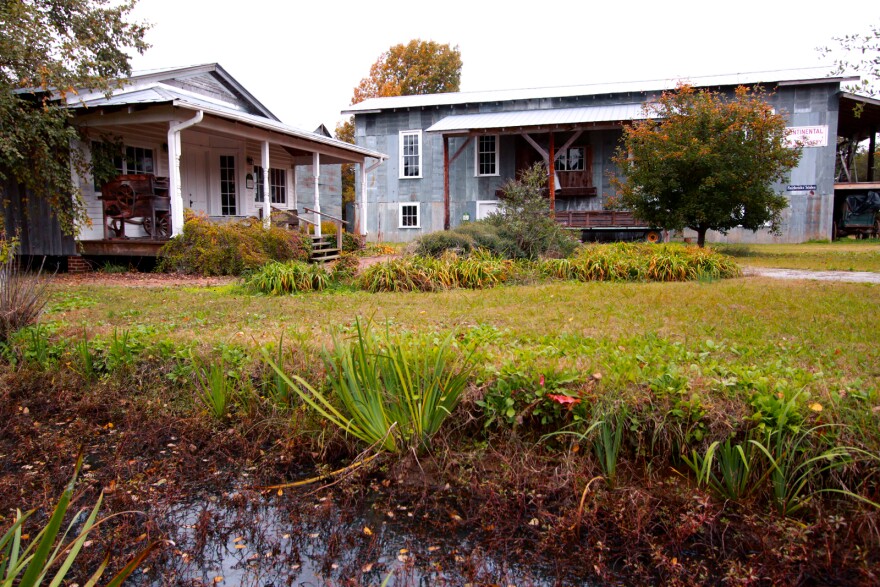If you've ever been out on the back roads near Jackson or Brownsville this time of year, you know why they call it the Tennessee Delta. Cotton is everywhere -- carpeting the fields, floating in the breeze like snow flurries.

So it's fitting that this story begins in an antique cotton gin, a giant wood and metal machine about the size of a shotgun house, and twice as tall. This one is nearly a century old. In fact, this gin hasn’t ginned since the 1950s.
"We're still not completely finished putting it all together the way it was," says its owner John Freeman.
Still, he thinks it’s pretty incredible.
Years ago, John Freeman put an in ad in a trade magazine. He wanted an old cotton gin. It didn’t have to work. It just had to be in one piece. He found one in Alabama, trucked it back to his place, and now shows it off to people like me.
"Now, if we could get two or three old gin mechanics that got interested in it," he says, "it could be done."
Getting it to function isn’t the point. The point is saving history. And that’s why John Freeman, with the help of his wife, Nancy, founded Green Frog Village just outside of Alamo, Tennessee. It’s a museum, a time capsule, and also one man’s obsession with the past.
Back in 1991, Dr. Freeman was at the end of his career as a medical missionary. He and his family had spent ten years in the forests of Thailand.
Then came the offer that reshaped his whole retirement. A local landowner wanted to clear a couple of rundown buildings off of her property: an old country store and a cabin that sat behind it. Freeman could have them if he moved them.
"So we took both of these buildings and moved them to Green Frog," he says. "Both of them had to be restored extensively. Next came a big log mule barn that someone wanted to get rid of."
Over the next two decades, word got around that Freeman was saving old buildings. There were plenty of them, weathering away in rural fields. Families who didn't have the heart to tear down their ancestral cabins gave them to Freeman, who carefully disassembled them with a fork lift, loaded them onto a flatbed, and reassembled them at Green Frog.

His collection grew. Now, for seven bucks, he’ll show you a whistle-stop train station, a one-room schoolhouse, a blacksmith shop, and an antique bootlegger's still given to him for display purposes only by the local police. On Sundays, a local preacher rents the small church Freeman rescued from a nearby town, complete with a bell, an antique pump organ and the original pews. The church had been saved once before from a fire, in 1957. The fire truck that saved it sits nearby.
In one building, two Green Frog regulars toy with the now-obsolete machines in Freeman’s early 20th Century print shop. Ben Murdock clicks away on an old Linotype, similar to the one he used at the Commercial Appeal back in the 1960s. And Johnny Tritt is operating an even older printing press.

"Did you ever see 'The Waltons' on TV?" Tritt asks, as he inks up the carriage. "John Boy Walton had a printing press and printed a weekly newspaper. This one here... thank goodness we got a motor on it now."
The grounds of Green Frog are immaculately maintained. Nancy Freeman invited members of the Bells Garden Club to transform the property into an arboretum, a botanical garden devoted to trees. Green Frog's trees -- nearly a hundred different species -- are all meticulously labeled.
If Green Frog Village were a big tourist attraction, one might imagine employees in period costumes, and maybe hayrides – the rural Tennessee version of Colonial Williamsburg.
But mostly it’s just Freeman, showing people his handiwork. He says he gets several hundred visitors a year, enough to pay the bills.
Having just celebrated his 80th birthday, Freeman is often asked what will become of Green Frog. His four grown children live elsewhere, and aren’t interested in the upkeep. He says he’s not sure. Only that he’ll keep going until he can’t.
And what keeps him going, he says, is a simple love for a world that just doesn’t exist any more.
"I think the history is enjoyable and the people's stories of what they did in the early days is very fascinating to me; a life that has disappeared," Freeman said, adding, "An old blacksmith, like we had here in Green Frog... One of the last times I saw him, he was at his forge. He had a hot piece of metal and he was beating on that. I could see what he was doing, but I asked him anyway. I said 'J.C., what are you doing?' 'Well, I'm making an axe head.' He had folded that steel over and he was forge welding it together. I said, 'J.C., you don't need to do that; you can buy those cheaper than you can make them.' And he said, "I know, I just want to know if I could still make one.'"




